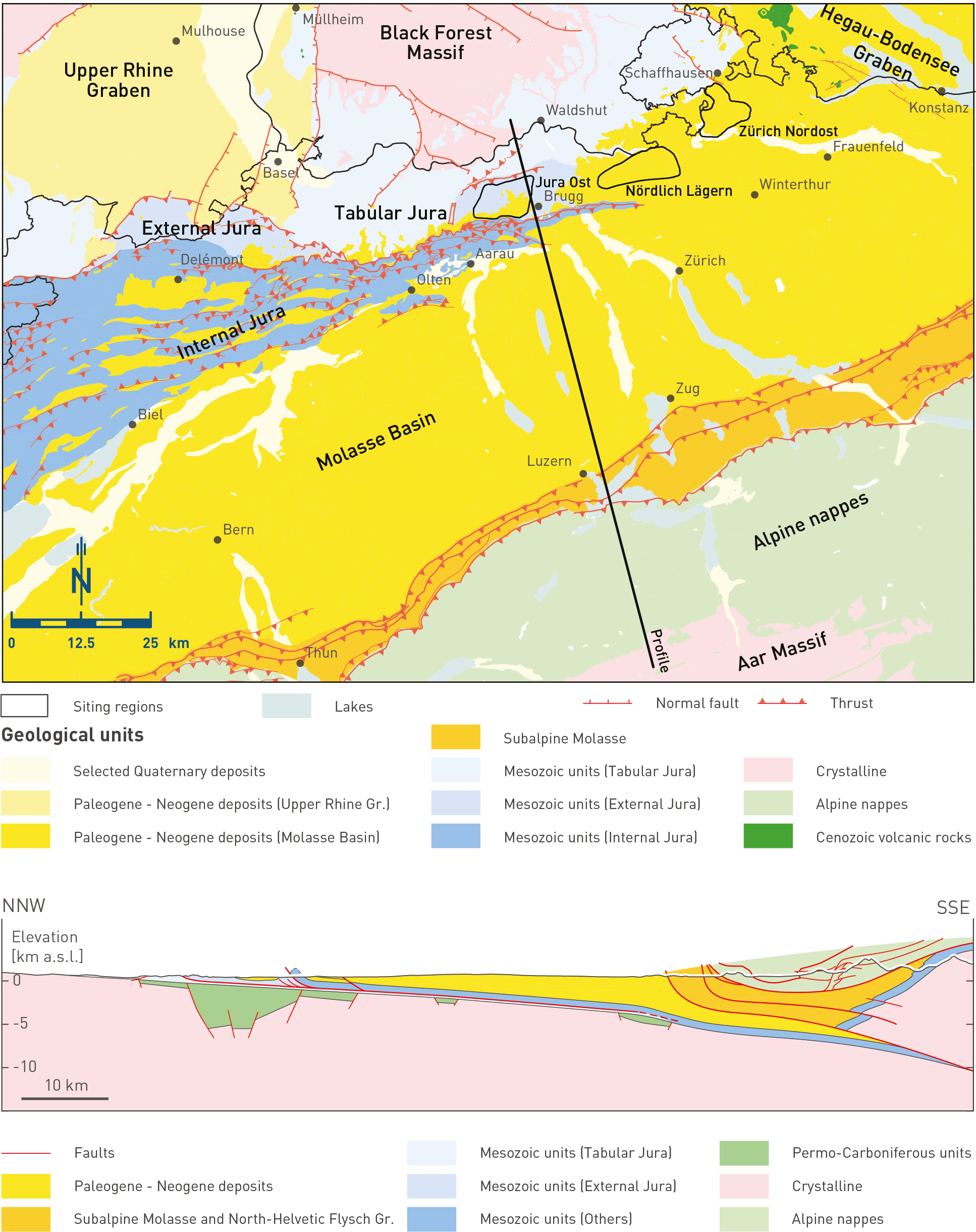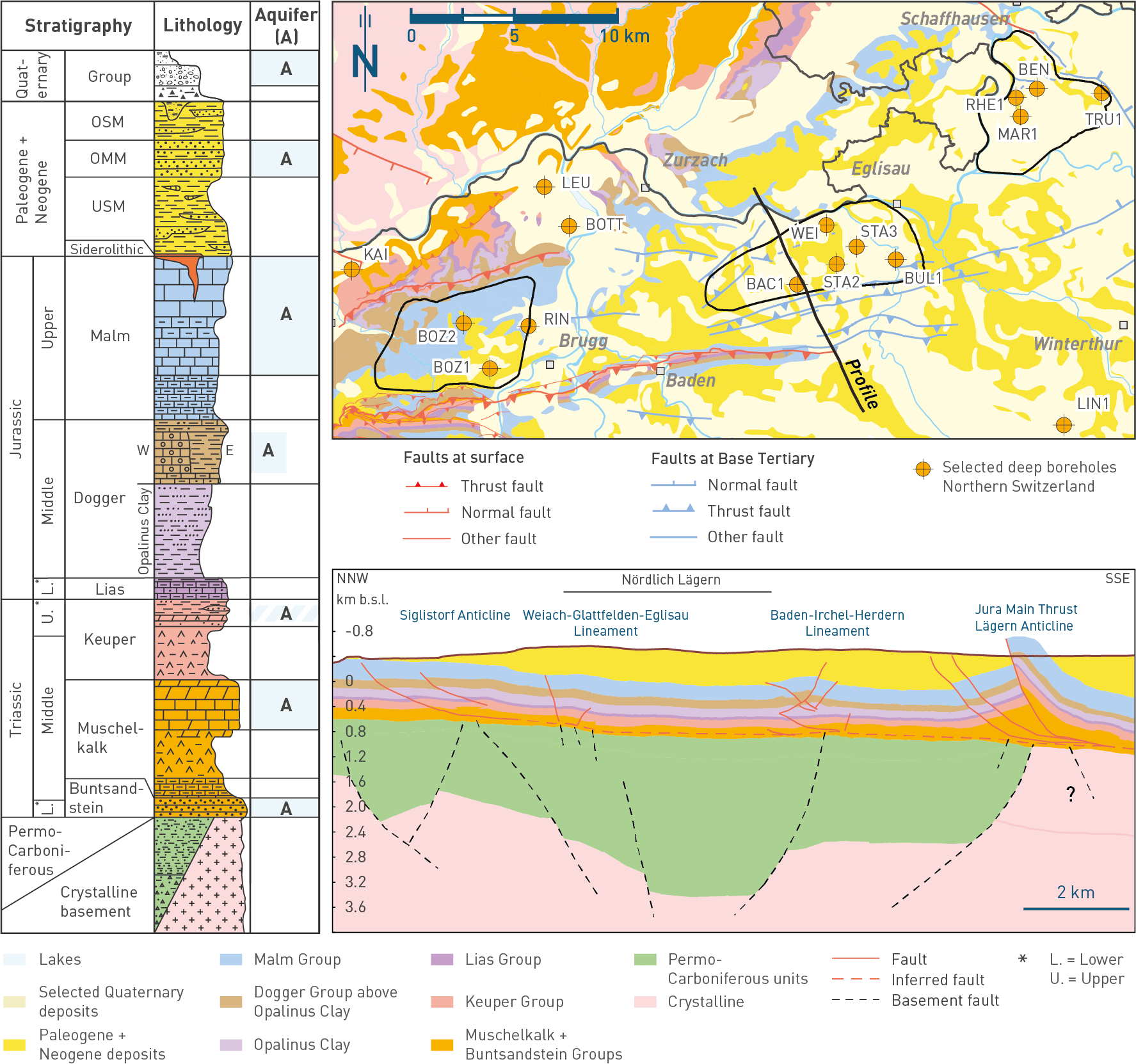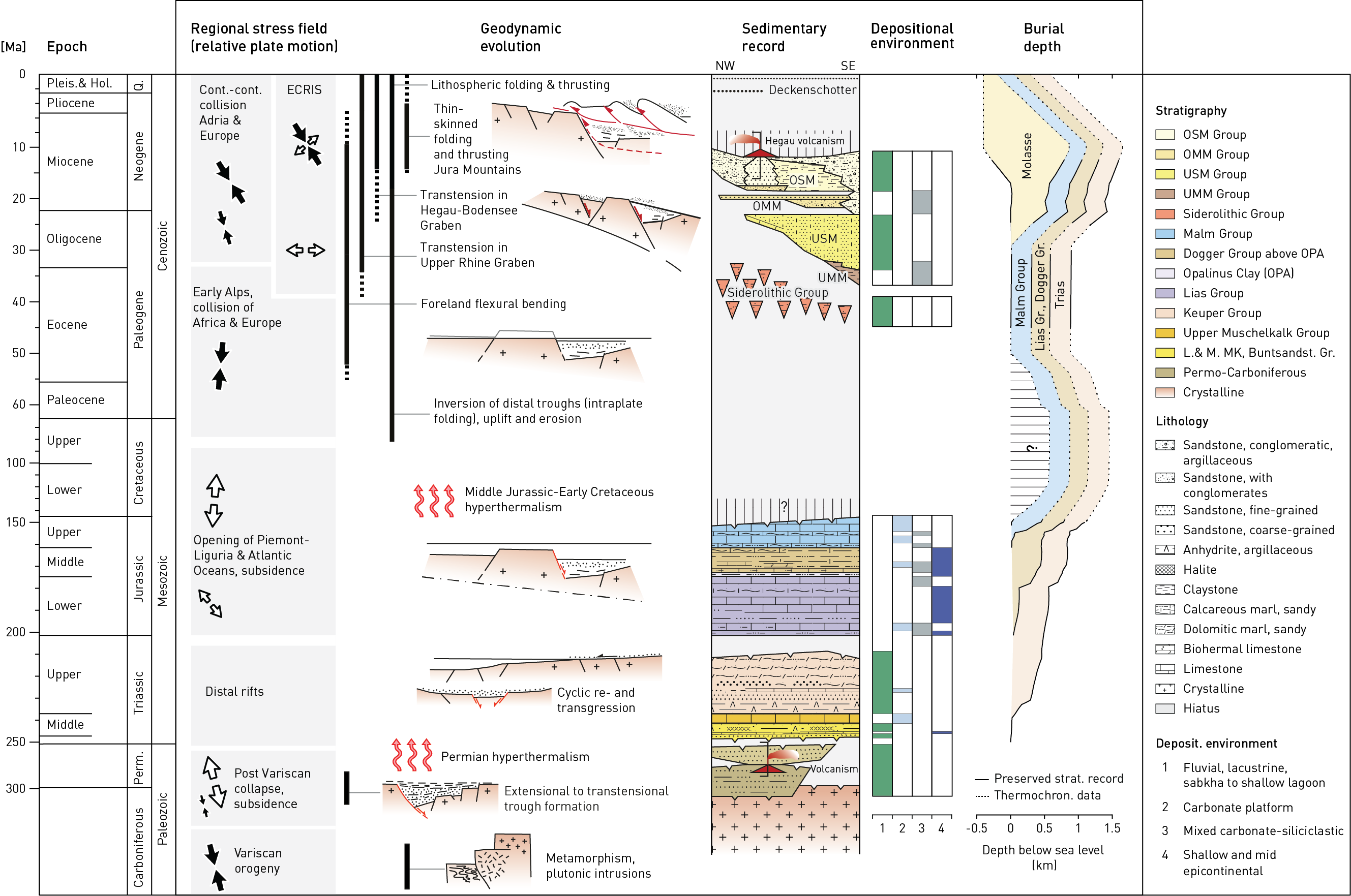Regional geological research over more than 100 years, complemented by site investigations (Chapter 2), provide a basis for reconstructing the geological evolution of Northern Switzerland and adjacent areas. The area considered in the present report is termed Northern Switzerland. It is bordered by the Black Forest Massif and the Tabular Jura in the north, the Hegau – Bodensee Graben in the northeast, the Upper Rhine Graben in the west, and the northern Swiss Molasse Basin in the south (Fig. 3‑2, Fig. 3‑3). In Northern Switzerland, the Mesozoic strata considered autochthonous are referred to as the Tabular Jura. The Jura Fold-and-Thrust Belt comprises External Jura and Internal Jura, where the Internal Jura is defined as the more strongly deformed part. A summary of the geological evolution of Northern Switzerland is presented in Fig. 3‑4.
The Black Forest Massif is composed mainly of crystalline rocks and is considered to be autochthonous. The Variscan orogeny, however, strongly deformed the crystalline basement of the Black Forest and adjacent Northern Switzerland, resulting in crustal-scale shear zones. Post-Variscan orogenic collapse and transtension resulted in the formation of the Konstanz – Frick Trough, which is a Permo-Carboniferous ENE-WSW-trending graben crossing Northern Switzerland. During the Permo-Carboniferous, coarse- to fine-grained siliciclastic sediments were deposited on alluvial plains under humid to arid conditions.
Towards the end of the Permian, the landscape was generally eroded to form a peneplain. In conjunction with renewed subsidence in the Triassic, Northern Switzerland lay within the southern part of the Central European Basin. Deposition during the Middle and Late Triassic was controlled by two major phases of transgression and regression preserved in the Muschelkalk and Keuper Groups respectively. Siliciclastic, evaporitic and carbonate sediments were deposited in terrestrial, coastal to marine depositional environments under subtropical to arid conditions.
During the Early and Middle Jurassic, mostly argillaceous and calcareous sediments (Lias and Dogger Groups) were deposited in a shallow epicontinental sea that formed during the opening of the Piemont – Liguria Ocean, part of the Neotethys. At this time, accommodation space was created by subsidence resulting from stretching and/or cooling of the lithosphere. During the Late Jurassic, mostly calcareous and marly sediments (Malm Group) were deposited in a shallow marine environment. The Mesozoic sequence outcrops in the Jura Fold-and-Thrust Belt. The Subalpine Molasse, the Swiss Molasse Basin and the Jura Fold-and-Thrust Belt together form the North Alpine Foreland. The Molasse Basin formed as flexural foreland basin. It comprises Paleogene and Neogene sedimentary rocks.
From the latest Mesozoic to the Oligocene, terrestrial conditions again prevailed in the region. Exhumation and a tropical climate led to intense weathering and erosion resulting in the top of the Malm Group being heavily karstified. Residual sediments (Siderolithic Group) of Eocene age can be found in palaeokarst depressions and infills.
North Alpine Foreland subsidence resulted in the Late Eocene in the deposition of the Lower Marine Molasse Group (UMM). In Northern Switzerland, terrestrial sedimentation resumed during the Late Oligocene with deposition of medium- to fine-grained siliciclastic sediments on large debris fan systems (Lower Freshwater Molasse Group, USM). Note that the classical German abbreviations for the Molasse deposits are used (Fig. 3‑4; Matter 1980). During late Early Miocene times, the latest transgression to affect Northern Switzerland led to deposition of sandstone and marl in shallow marine and coastal environments (Upper Marine Molasse Group, OMM).

Fig. 3‑2:Simplified tectono-geological map of Northern Switzerland with a profile between the Aar Massif and the Black Forest Massif
Modified after Nagra (2014b). Geological map 1:500'000 was simplified (©swisstopo), i.e. no faults are shown within the Alps. Gr.: Graben (map above) or Group (cross-section below).
The Middle Miocene saw the opening of the Hegau – Bodensee Graben coeval with the deposition of medium- to fine-grained siliciclastic sediments on large debris fan systems (Upper Freshwater Molasse Group, OSM). The main deformation in the Jura Fold-and-Thrust Belt occurred within the Middle to Late Miocene to Pliocene, but it remains active until today.
During the Pliocene, the river drainage evolved from eastward-directed (Aare-Danube draining towards the Black Sea) to a westward- (Aare-Doubs draining towards the Mediterranean) and finally to a northward-directed system (Aare-Rhine draining towards the North Sea). During the Quaternary, glaciers advanced and retreated in the Alpine Foreland driven by glacial/ interglacial climate cycles. Together, these climate cycles, tectonic uplift and the progressive eastward migration of the Rhine River catchment resulted in fluvial and glacial incision. In the forefield of the glaciers, vast gravel plains were deposited. Glaciers also incised overdeepened troughs, which were filled by lacustrine sand and silt. With the disappearance of the glaciers in the North Alpine Foreland, fluvial and hillslope processes dominated the pre-sculptured landscape.

Fig. 3‑3:Stratigraphic column, geological map and profile of Northern Switzerland
Geological map modified after 1:500'000 geological map of Switzerland (©swisstopo). Cross-section modified after Meier et al. (2014) with the recent results from the 3D seismic interpretation.

Fig. 3‑4: Timeline focusing on the geological evolution of Northern Switzerland
Modified after Müller et al. (2002). Large-scale stress field characteristics and tectonic events after Schori (2021), burial evolution after Mazurek et al. (2006). White arrows indicate tension-dominated stress field. Black arrows indicate compression-dominated stress field. Pleis.: Pleistocene, Hol.: Holocene, Q.: Quaternary, Perm.: Permian, Cont.: Continent, ECRIS: European Cenozoic Rift System, OSM: Upper Freshwater Molasse, OMM: Upper Marine Molasse, USM: Lower Freshwater Molasse, UMM: Lower Marine Molasse, Gr.: Group.

